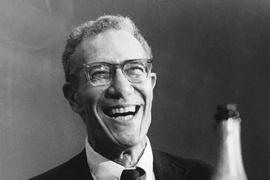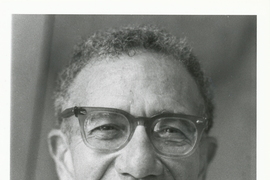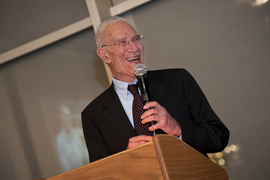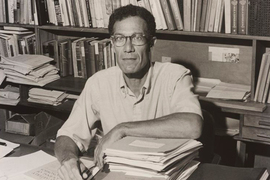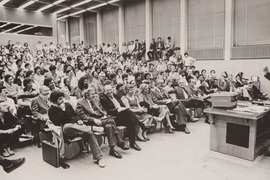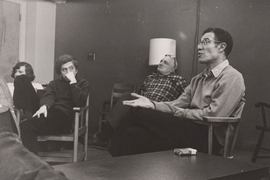MIT Institute Professor Emeritus Robert M. Solow, a groundbreaking economist whose work on technology and economic growth profoundly influenced the field, and whose ethos of engaged teaching and collegial collaboration deeply shaped MIT’s Department of Economics, died on Thursday. He was 99.
Solow’s research, especially a series of papers in the 1950s and 1960s, helped demonstrate at a fundamental level how modern economic growth occurs. As his work shows, technological advances, broadly defined, are responsible for the bulk of modern economic growth, more than simple population growth or capital expansion. This insight opened up a whole new series of research questions within academia, and influenced policymakers in many countries.
For these contributions, Solow was the recipient of the 1987 Nobel Prize in economics, with the citation mentioning his “exceptional contributions” as well as the “dramatic impact” of his work. In 2014, Solow was also awarded the Presidential Medal of Freedom, the highest civilian honor in the U.S., from President Barack Obama.
At MIT, Solow was also celebrated for his commitment to teaching in the classroom, and to engaging in ongoing scholarly discussions with colleagues and students, which he carried out with intellectual rigor, clear expression, and a continually affable, good-humored style. Hired by MIT in 1949, Solow was one of the core figures who helped turn the Department of Economics into a powerhouse program. After retirement, he was an Institute Professor Emeritus.
In all, Solow was affiliated with MIT for a remarkable 74 years.
“Bob Solow, who not only won a Nobel Prize but also saw four of his former students similarly honored, was a path-breaking researcher and extraordinary teacher,” says James Poterba, the Mitsui Professor of Economics at MIT and former head of the Institute’s Department of Economics. “He laid the foundation for the modern study of economic growth and quantified the key role of technological progress in contributing to it. His legendary lectures, often delivered without notes, inspired generations of MIT students. A key architect of the post-war rise of the MIT Department of Economics, he was also a central contributor to its culture of comraderie and public-spiritedness that continues to this day.”
MIT President Sally Kornbluth also paid tribute to Solow’s career and achievements.
“In the years after World War II, Bob Solow helped transform MIT’s Department of Economics — and the field itself,” Kornbluth said. “As the department rose to international prominence, Bob permanently changed how we understand the forces that make economies grow. From what I’ve learned of his rigor, brilliance and world-changing influence as a scholar, his clarity and attentiveness as a teacher, and his generosity and kindness as a mentor and colleague, he represented an MIT ideal.”
Video: MIT Infinite History Project
Home from the war, on to MIT
Robert Merton Solow was born on August 23, 1924, and grew up in Brooklyn, New York, where his father was a fur merchant. A standout student from early on, Solow skipped two grades in school, and earned a scholarship to attend Harvard University at age 16, in 1940. Two years later, after the U.S. had entered World War Two, Solow enlisted in the U.S. Army. Having learned some German in college, Solow spent much of his wartime service in Italy in seemingly risky circumstances, working in a company intercepting German radio signals, in specially equipped trucks just behind the front.
When the Allies won the war, he re-entered Harvard in 1945. Late that summer, Solow married Barbara “Bobby” Lewis, a Radcliffe College student whose interest in economics helped spur his own entry into the field. In short order, Solow finished his undergraduate degree and completed Harvard’s PhD program in economics, producing a PhD thesis on new methods of studying income inequality.
When Solow joined the MIT Department of Economics in 1949, it was a small program largely oriented around teaching. However, one faculty member, Paul Samuelson, was in the process of overhauling large portions of economics with his emphasis on mathematical rigor and formal analysis.
Samuelson and Solow, along with many colleagues from these early days — including Charles Kindleberger, Harold Freeman ’31, Cary Brown, Robert Bishop, and George Shultz PhD ’49, the future U.S. secretary of state — helped the program grow and thrive, while it added luminaries such as Franco Modigliani. By 1960, the MIT department was considered to be at the top of the discipline.
It was also considered to be an informal, open, student-friendly place — “the happiest economics department,” as a visiting professor from Harvard termed it. Solow often attributed that to Samuelson’s own lack of airs, telling an MIT interviewer in 2011, on the occasion of MIT’s 150th anniversary, “if you have the best economist in the world in the department, and he’s not being stuffy about anything it must be hard for anybody else to be stuffy.” But Solow’s personable approach to academic life heavily influenced the emerging departmental culture as well.
A new theory of economic growth
Solow’s own research took flight in the 1950s, when he began producing his landmark work on technological change and growth, which altered the way economists thought about the subject. His 1956 paper, “A Contribution to the Theory of Economic Growth,” in the Quarterly Journal of Economics, modeled how even increases in population and capital investment will not sustain economic growth. Rather growth mostly stems from technological changes.
In a 1957 follow-up paper, “Technical Change and the Aggregate Production Function,” in The Review of Economics and Statistics, Solow brought data to the problem. Specifically, using historical U.S. economic statistics, he showed that the aggregate of technological, educational, and skill-related changes, as distinct from population increases and capital investment, had generated roughly 80 percent of growth. Solow called this process “Total factor productivity.”
Beyond that, in 1960 Solow added a new layer to his thinking in another paper, “Investment and Technical Progress,” to account for the idea that capital investment itself can become more advanced.
Understanding the drivers of economic growth, Solow said during the 2011 interview, was an issue that “was in the air. It was sort of one of the outstanding problems.”
Before doing his research, Solow added, “I had taken it for granted like everybody else, that the main thing that pushed an economy to grow was the increase in population and the accumulation of capital goods … And I found that if you looked at the data with all of the theory you could bring to bear, you could not make that story hold water. And the only way of accounting for what we’d seen in the U.S. between 1909 and 1950-something was if the main driving force for growth had been what I chose to call technical progress. Meaning what was in my mind was improving technology, but also included improving skills.”
Solow’s work was quickly recognized as a breakthrough in the field. In 1961, he was awarded the John Bates Clark Medal, given by the American Economic Association to the best economist under the age of 40. Much later, in 2000, Solow was awarded the National Medal of Science. He was elected a member of the National Academy of Sciences, and a Fellow of the British Academy.
Solow had terms as president of the American Economic Association, and the Econometric Society. He also spent time working in the policy sphere. In the 1970s, Solow served as member and chairman of the Board of Directors of the Federal Reserve Bank of Boston. And from 1961 to 1962, Solow served on the Council of Economic Advisors in the Kennedy administration, along with prominent economists such as Kenneth Arrow and James Tobin.
“We thought we had one of the best economics departments in the country, sitting there in the Old Executive Office Building,” Solow quipped to MIT News in 2019.
Devoted to teaching
For all of his research accomplishments and policy service, Solow also thrived in the classroom, and as a committed, encouraging advisor to students.
“You only have really good ideas once in a while,” Solow told MIT News. “I would rather teach a really bright student than write a mildly interesting paper.”
When it came to teaching undergraduates, Solow would annually tear up his old lecture notes, and force himself to re-examine how he was presenting material to them. He came to believe he did his best teaching by the third time he lectured on a particular subject.
As a graduate advisor, Solow would put in long hours providing detailed feedback to students about their research papers, often reading their work in the evenings, across the living room from Barbara Solow — who also received a PhD from Harvard, and taught at Brandeis and Boston University, as a scholar of Irish economic history, as well as the Carribean slave trade.
Over time, Solow served as principal advisor to over 70 doctoral students, many of whom became highly accomplished economists. Four doctoral students for whom Solow was the main advisor — George Akerlof PhD ’66, Peter Diamond PhD ’63, William Nordhaus PhD ’67, and Joseph Stiglitz PhD ’67 —eventually won the Nobel Prize themselves. (One student who wrote an undergraduate economics thesis for Solow, H. Robert Horvitz ’68, also won the Nobel Prize in Physiology or Medicine.)
“He was extremely generous with both his time and his ideas,” Akerlof told MIT News in 2019. As a graduate student, Akerlof found, “the faculty were there to greet students on the first day we arrived at MIT, and to give us advice. I mean, you would not expect the most distinguished professor at the best economics department to be there, waiting for you. That was extraordinary.”
Solow’s intellectual and professional commitment to his students, and his active mentorship, earned him life-long admiration from those who had studied with him.
“Paul Samuelson was royalty, but Bob was very much the prime minister running the country,” the economist Avinash Dixit PhD ’68 recalled, in remarks for a 90th-birthday gathering for Solow, in 2014.
As it happens, Samuelson and Solow worked for decades in the same common suite of offices, talking economics at length. Engaging with colleagues, Solow strongly felt, was one of the best ways to produce better scholarship.
“More than being pleasurable, I think it makes for good work,” Solow told MIT News. “Talking to your colleagues — or, in my case, standing at a blackboard with them and talking and scribbling — improves the product.”
For those fortunate enough to have been both students and colleagues of Solow, the remarkable economist’s passing evoked both sadness, and gratitude for all he contributed.
“I was fortunate to see many phases of the Bob Solow experience — to have him as an undergraduate teacher, where his class was widely viewed as the highlight of the economics curriculum, to see him as a dedicated thesis advisor, to have insightful research conversations, and to work with him as an external policy expert,” says Jonathan Gruber, Ford Professor of Economics and current head of the MIT Department of Economics. “In every phase, Bob was amazing — always thoughtful, well-spoken, clear and kind. He is a role model for all economists.”
Solow's surviving family members include his three children, Andrew, John, and Katherine; eight grandchildren; and three great-grandchildren.
